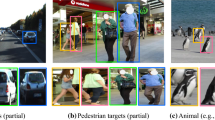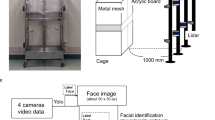Abstract
Analysis of primate behavior is crucial for neuroscience research and drug evaluation. Although many methods of automatically recording animal behavior have been proposed, none of them can meet the requirements of both speed and accuracy. In order to implement real-time and high-precision automatic recording of primate behavior, we proposed a novel Joint Detection and Classification (JDC) model to predict the location, identity and actions of monkeys simultaneously. Different from the existing complex non-end-to-end models, our model is the first end-to-end method in this field. In order to explore how to efficiently fuse spatiotemporal information, we constructed the JDC model with a single frame or different fusion approaches. In addition, we collected a new dataset named Spatiotemporal Action Localization of Monkeys in a Group (SALMG), which is the first one containing the location, identity and actions of monkeys in a group. The JDC model with middle fusion approach (JDC-MF) on the SALMG dataset outperforms all compared methods. The F1 score of the JDC-MF is 81.4%, which is 15.3% and 10.6% higher than the Separate Detection and Classification model and the two-stage model, respectively. Moreover, the JDC-MF achieves the highest accuracy of 99.1 % on public Pig Novelty Preference Behavior dataset, which is 4.1% higher than the second-best model. The JDC-MF only takes 0.027 s for a clip on a Nvidia GeForce RTX 2080 Ti. Therefore, the JDC-MF can realize real-time and high-precision spatiotemporal action localization of monkeys, and provide an effective reference scheme for automatic recording and analysis of animal behavior. Code has been made available at: https://github.com/Kewei-Liang/JDC-MF.











Similar content being viewed by others
Data availability
The SALMG dataset has been made available at: https://drive.google.com/drive/folders/16ZCkv0j1r26eRNydXYFAtr_fKp-ywIJd?usp=share_link.
References
Klein CJMI, Budiman T, Homberg JR, Verma D, Keijer J, Schothorst EMV (2022) Measuring locomotor activity and behavioral aspects of rodents living in the home-cage. Front Behav Neurosci 16:877323. https://doi.org/10.3389/fnbeh.2022.877323
Kitamural A, Takata R, Aizawa R, Watanabe H, Wada T (2018) A murine model of atopic dermatitis can be generated by painting the dorsal skin with hapten twice 14 days apart. Sci Rep 8(1):5988. https://doi.org/10.1038/s41598-018-24363-6
Yoo KH, Lee SJ (2010) Experimental animal models of neurogenic bladder dysfunction. Int Neurourol J 14(1):1–6. https://doi.org/10.5213/inj.2010.14.1.1
Labuguen R, Matsumoto J, Negrete SB, Nishimaru H, Nishijo H, Takada M et al (2020) MacaquePose: a novel “in the wild’’ macaque monkey pose dataset for markerless motion capture. Front Behav Neurosci 14:581154. https://doi.org/10.3389/fnbeh.2020.581154
Pang W, Song JH, Lu Y, Zhang XL, Zheng HY, Jiang J et al (2018) Host restriction factors APOBEC3G/3F and other interferon-related gene expressions affect early HIV-1 infection in northern pig-tailed macaque (Macaca leonine). Front Immunol 9:1965. https://doi.org/10.3389/fimmu.2018.01965
Howell LL, Murnane KS (2008) Nonhuman primate neuroimaging and the neurobiology of psychostimulant addiction. Ann N Y Acad Sci 1141:176–194. https://doi.org/10.1196/annals.1441.023
Waguespack HF, Aguilar BL, Malkova L, Forcelli PA (2020) Inhibition of the deep and intermediate layers of the superior colliculus disrupts sensorimotor gating in monkeys. Front Behav Neurosci 14:610702. https://doi.org/10.3389/fnbeh.2020.610702
Novak MA, Meyer JS (2021) A rhesus monkey model of non-suicidal self-injury. Front Behav Neurosci 15:674127. https://doi.org/10.3389/fnbeh.2021.674127
Kiss T, Hoffmann WE, Scott L, Kawabe TT, Milici AJ, Nilsen EA et al (2011) Role of thalamic projection in NMDA receptor-induced disruption of cortical slow oscillation and short-term plasticity. Front Psychiatry 4:2–14. https://doi.org/10.3389/fpsyt.2011.00014
Iredale SK, Nevill CH, Lutz CK (2010) The influence of observer presence on baboon (Papio spp.) and rhesus macaque (Macaca mulatta) behavior. Appl Anim Behav Sci 122(1):53–57. https://doi.org/10.1016/j.applanim.2009.11.002
Anderson DJ, Perona P (2014) Toward a science of computational ethology. Neuron 84(1):18–31. https://doi.org/10.1016/j.neuron.2014.09.005
Carreira J, Zisserman A (2017) Quo vadis, action recognition? a new model and the kinetics dataset. In: IEEE Conference on computer vision and pattern recognition (CVPR) pp. 4724-4733. https://doi.org/10.1109/CVPR.2017.502
Soomro K, Zamir AR, Shah M (2012) UCF101: A dataset of 101 human actions classes from videos in the wild. https://doi.org/10.48550/arXiv.1212.0402, arXiv:1212.0402
Kuehne H, Jhuang H, Garrote E, Poggio T, Serre T (2011) HMDB: a large video database for human motion recognition. In: International conference on computer vision, pp. 2556-2563. https://doi.org/10.1109/ICCV.2011.6126543
Qiao Y, Guo Y, Yu K, He D (2020) C3D-ConvLSTM based cow behaviour classification using video data for precision livestock farming. Comput Electron Agric 193:106650. https://doi.org/10.1016/j.compag.2021.106650
Ma S, Zhang Q, Li T, Song H (2022) Basic motion behavior recognition of single dairy cow based on improved Rexnet 3D network. Comput Electron Agric 194:106772. https://doi.org/10.1016/j.compag.2022.106772
Fang C, Zhang T, Zheng H, Huang J, Cuan K (2021) Pose estimation and behavior classification of broiler chickens based on deep neural networks. Comput Electron Agric 180:105863. https://doi.org/10.1016/j.compag.2020.105863
Lozano P, Gavrilets S, Sánchez A (2020) Cooperation, social norm internalization, and hierarchical societies. Sci Rep 10(1):15359. https://doi.org/10.1038/s41598-020-71664-w
Lidster K, Owen K, Browne WJ, Prescott MJ (2019) Cage aggression in group-housed laboratory male mice: an international data crowdsourcing project. Sci Rep 9(1):15211. https://doi.org/10.1038/s41598-019-51674-z
Gu C, Sun C, Ross DA et al (2018) AVA: a video dataset of spatio-temporally localized atomic visual actions. In: IEEE/CVF Conference on computer vision and pattern recognition, pp. 6047-6056. https://doi.org/10.1109/CVPR.2018.00633
Marks M, Qiuhan J, Sturman O, Ziegler LV, Kollmorgen S, Behrens WVD et al (2022) Deep-learning-based identification, tracking, pose estimation and behaviour classification of interacting primates and mice in complex environments. Nat Mach Intell 4(4):331–340. https://doi.org/10.1038/s42256-022-00477-5
Bailey DW, Trotter MG, Knight CW, Thomas MG (2018) Use of GPS tracking collars and accelerometers for rangeland livestock production research. Transl Anim Sci 2(1):81–88. https://doi.org/10.1093/tas/txx006
Li D, Zhang K, Li Z, Chen Y (2020) A spatiotemporal convolutional network for multi-behavior recognition of pigs. Sensors 20(8):2381. https://doi.org/10.3390/s20082381
Feichtenhofer C, Fan H, Malik J, He K (2019) Slowfast networks for video recognition. In: IEEE/CVF International conference on computer vision (ICCV) pp. 6201-6210. https://doi.org/10.1109/ICCV.2019.00630
Kang X, Li S, Li Q, Liu G (2022) Dimension-reduced spatiotemporal network for lameness detection in dairy cows. Comput Electron Agric 197:106922. https://doi.org/10.1016/j.compag.2022.106922
Wang H, Zhang S, Zhao S, Lu J, Wang Y, Li D et al (2022) Fast detection of cannibalism behavior of juvenile fish based on deep learning. Comput Electron Agric 198:107033. https://doi.org/10.1016/j.compag.2022.107033
Fleming SA, Dilger RN (2017) Young pigs exhibit differential exploratory behavior during novelty preference tasks in response to age, sex, and delay. Behav Brain Res 321:50–60. https://doi.org/10.1016/j.bbr.2016.12.027
Shirke A, Golden R, Gautam M, Green-Miller A, Caesar M, Dilger RN (2021) Vision-based behavioral recognition of novelty preference in pigs. https://doi.org/10.48550/arXiv.2106.12181, arXiv:2106.12181
Karpathy A, Toderici G, Shetty S, Leung T, Sukthankar R, Fei-Fei, L (2014) Large-scale video classification with convolutional neural networks. In: IEEE Conference on computer vision and pattern recognition, pp. 1725-1732. https://doi.org/10.1109/CVPR.2014.223
Lin TY, Dollar P, Girshick R, He K, Hariharan B, Belongie S (2014) Feature pyramid networks for object detection. In: IEEE Conference on computer vision and pattern recognition (CVPR) pp. 936–944. https://doi.org/10.1109/CVPR.2017.106
Liu S, Qi L, Qin H, Shi J, Jia J (2018) Path aggregation network for instance segmentation. In: IEEE/CVF Conference on computer vision and pattern recognition, pp. 8759-8768. https://doi.org/10.1109/CVPR.2018.00913
Donahue J, Hendricks LA, Guadarrama S, Rohrbach M, Venugopalan S, Saenko K et al (2017) Long-term recurrent convolutional networks for visual recognition and description. IEEE Trans Pattern Anal Mach Intell 39(4):677–691. https://doi.org/10.1109/TPAMI.2016.2599174
Ji S, Xu W, Yang M, Yu K (2013) 3D convolutional neural networks for human action recognition. IEEE Trans Pattern Anal Mach Intell 35(1):221–31. https://doi.org/10.1109/TPAMI.2012.59
Lin J, Gan C, Han S (2019) TSM: Temporal shift module for efficient video understanding. In: IEEE/CVF International conference on computer vision (ICCV), pp. 7082-7092. https://doi.org/10.1109/ICCV.2019.00718
Bochkovskiy A, Wang CY, Liao HYM (2020) Yolov4: Optimal speed and accuracy of object detection. https://doi.org/10.48550/arXiv.2004.10934, arXiv:2004.10934
Redmon J, Divvala S, Girshick R, Farhadi A (2016) You only look once: unified, real-time object detection. In: IEEE Conference on computer vision and pattern recognition (CVPR), pp. 779-788. https://doi.org/10.1109/CVPR.2016.91
Redmon J, Farhadi A (2017) YOLO9000: better, faster, stronger. In: IEEE Conference on computer vision and pattern recognition (CVPR), pp. 6517-6525. https://doi.org/10.1109/CVPR.2017.690
Redmon J, Farhadi A (2018) Yolov3: an incremental improvement. https://doi.org/10.48550/arXiv.1804.02767, arXiv:1804.02767
Acknowledgments
This work has been partially supported by the Chinese National Natural Science Foundation Projects (#82090051, #81871442), and in part by the Youth Innovation Promotion Association CAS (#Y201930). We thank JOINN Laboratories Co., Ltd for its support on the experimental site and equipment. We thank Chenlu Jie, Wenxuan Fan, Jiawei Huang et al. for their contributions to data annotation.
Author information
Authors and Affiliations
Corresponding author
Ethics declarations
Conflict of interest
The authors declare that they have no known competing financial interests or personal relationships that could have appeared to influence the work reported in this paper.
Ethical approval
Our experiment did not interfere with the normal life of monkeys and was reviewed and approved by Animal Management and Use Committee of JOINN Laboratories Co., Ltd.
Additional information
Publisher's Note
Springer Nature remains neutral with regard to jurisdictional claims in published maps and institutional affiliations.
Supplementary Information
Below is the link to the electronic supplementary material.
Supplementary file 2 (mp4 45370 KB)
Rights and permissions
Springer Nature or its licensor (e.g. a society or other partner) holds exclusive rights to this article under a publishing agreement with the author(s) or other rightsholder(s); author self-archiving of the accepted manuscript version of this article is solely governed by the terms of such publishing agreement and applicable law.
About this article
Cite this article
Liang, K., Chen, Z., Yang, S. et al. The joint detection and classification model for spatiotemporal action localization of primates in a group. Neural Comput & Applic 35, 18471–18486 (2023). https://doi.org/10.1007/s00521-023-08670-2
Received:
Accepted:
Published:
Issue Date:
DOI: https://doi.org/10.1007/s00521-023-08670-2




